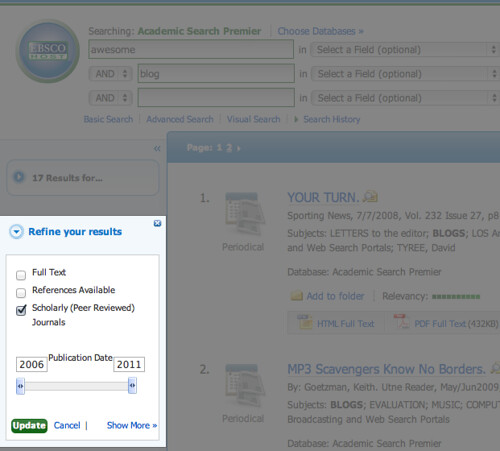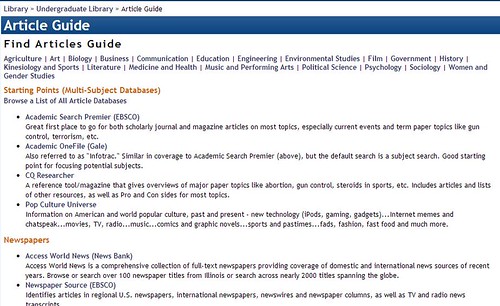Since you read part one of this post last week (right?), you know how to get to the UGL’s list of recommended databases so that you can begin searching for articles on your research topic.
This week, we want to give you a little insight into how to tell if an article is actually peer-reviewed. Not all articles available through library databases are peer-reviewed, scholarly articles, so it is important to look carefully at the articles you find to determine if they meet the requirements for your research. Databases include articles from popular periodicals (like Time magazine), scholarly journals, and trade periodicals (like Parks & Recreation – not the TV show!). This graphic gives you an idea of what library databases include:
In many databases, you can actually limit your search so that you just retrieve articles from scholarly journals:

Check the box “Scholarly (Peer-Reviewed) Journals” to limit to articles from scholarly journals in an EBSCO database. Click “Update” to apply the limit.
This limit is not foolproof! Why? Because not all works published in scholarly journals are actually “peer-reviewed articles.” Here’s the reason: scholarly journals also publish things like book reviews, editorials, and news releases. These are NOT what your professors mean when they say “peer-reviewed articles.” The scholarly articles your professor wants you to use present original research, usually in a longer format, often including graphics such as charts and tables, and always including citations for all material presented.
SO: even if you limit your search to just find articles from peer-reviewed journals, you still need to examine the article citation, abstract, and even some of the full text, to determine if it’s actually a scholarly, peer-reviewed article. Answer questions such as these for every resource you want to use: Are the authors’ credentials included? Do they cite sources? Are their conclusions based on evidence (and do they provide this evidence)?
The UGL has also created several web pages to assist you with evaluating sources!
Is it scholarly? Tips for critically evaluating your information resources: This page gives you criteria you can use to analyze the sources you find. Use the criteria found on this page when trying to determine whether or not an article you find is actually a peer-reviewed article and not simply a news release or editorial found in a scholarly journal.
Is it scholarly? Distinguishing periodical types: Here you will find criteria on how to tell the difference between scholarly articles and those from trade periodicals (written for and by people in a particular profession) and popular periodicals (such as People and GQ).
Remember: you may find articles from all types of periodicals (magazines, newspapers, journals) when you search in a database. It is important to evaluate what you see so you know if it works for your assignment!




